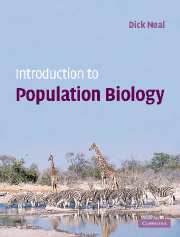Book contents
- Frontmatter
- Contents
- Preface
- Acknowledgements
- PART I Evolution by natural selection
- PART II Simple population growth models and their simulation
- PART III Population genetics and evolution
- PART IV Demography
- PART V Interactions between species, and the behaviour of individuals
- Chapter 17 Interspecific competition and amensalism
- Chapter 18 Predation
- Chapter 19 Animal behaviour, natural selection and altruistic traits
- Chapter 20 Sexual selection and mating systems
- Chapter 21 Epilogue
- Glossary
- Solutions to problems
- References
- Index
Chapter 18 - Predation
- Frontmatter
- Contents
- Preface
- Acknowledgements
- PART I Evolution by natural selection
- PART II Simple population growth models and their simulation
- PART III Population genetics and evolution
- PART IV Demography
- PART V Interactions between species, and the behaviour of individuals
- Chapter 17 Interspecific competition and amensalism
- Chapter 18 Predation
- Chapter 19 Animal behaviour, natural selection and altruistic traits
- Chapter 20 Sexual selection and mating systems
- Chapter 21 Epilogue
- Glossary
- Solutions to problems
- References
- Index
Summary
We typically think of predators as animals that kill and eat other animals, such as lions eating zebra, or spiders eating flies. These are true predators that consume prey animals to obtain food for their own survival and reproduction. However, there are other types of predators that have some but not all of the features of true predators. These include parasitoids, which are hymenopterans or dipterans that are free-living in the adult stage, but whose larvae live in or on other arthropods (usually insects), doing little harm at first but eventually consuming and killing the host just prior to pupation. There are also plant and animal parasites that live in an obligatory relationship with another species, and harm their hosts, but usually do not kill it. Then there are animals that eat plants, the herbivores. Seed-eating herbivores act like true predators, because they consume all of their ‘prey’. Others act rather like parasites, because they live in close association with the plant and derive their nourishment from it (e.g. aphids). However, the majority of herbivores only consume a part of the plant, and their detrimental effects can be very variable. Partial or complete defoliation of a plant may have a large effect on the plant's fitness, by reducing its growth rate and seed production, and possibly leaving the plant more vulnerable to attack by plant pathogens.
- Type
- Chapter
- Information
- Introduction to Population Biology , pp. 292 - 317Publisher: Cambridge University PressPrint publication year: 2003



